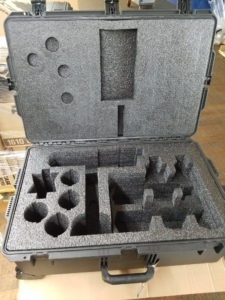 At H. Loeb, high quality, custom foam packaging solutions are designed to ensure safe, reliable transit of sensitive components, equipment, and products. Whether a large corporate OEM that knows what packaging is required or a single customer unsure of what packaging they may need, our engineering team with clients to determine the best layout, design and case to protect your products large and small.
At H. Loeb, high quality, custom foam packaging solutions are designed to ensure safe, reliable transit of sensitive components, equipment, and products. Whether a large corporate OEM that knows what packaging is required or a single customer unsure of what packaging they may need, our engineering team with clients to determine the best layout, design and case to protect your products large and small.
Layout and design options depend in large part on the products being shipped, as do the foam or foams used in custom packaging. The layout of the case will be determined by its product, parts and components. Various tools and machining—die cutting, kiss cutting, CNC laser cutting, CNC knife cutting, and CNC routing and laminating services—are onsite for custom fabrication and molding.
Design Requirements
Design requirements are determined by several factors. The type of equipment being shipped—its weight, size, composition, and shape—are all details that go into creating a design that offers the best packaging solution. The interior packaging material itself is determined by the protection required for the product. Customized foam and foam inserts are designed for a perfect, snug fit. Even logos and other aesthetics can be incorporated into custom packaging design.
Foam is easily fabricated and molded to fit the product dimensions, and it is done so at a significantly lower weight. For linings and insert material, foam interiors provide the necessary cushioning and support needed for custom packaging, and its lightweight is favored by industries to keep shipping costs down. However, foams have different mechanical and material properties that need to be taken into consideration before selecting a packaging material for a product.
Mechanical Properties of Foam
The overall mechanical properties of foam make it the ideal material for shipping fragile or sensitive parts or components safely. Its multi-functional applications and protective properties ensure safe transit and delivery of products. Foams dampen vibration and provides excellent shock protection from accidental, incidental or intentional drops or abuse from automated sorting systems and mishandling. They provide surface protection against scrapes, scratches, dings and nicks. During transit, foams also provide thermal and insulative protection from moisture and temperature fluctuations.
Because foams are manufactured with different cell structures, open or closed, they offer distinct material properties for specific design applications. For example, three common foams used in custom packaging—polyethylene, polyurethane, and cross-linked foams—each have different material properties better suited for packaging one product over another.
Polyethylene
Polyethylene (PE) foams are versatile, closed-cell foams noted for their strength and rigidity. It’s used in custom foam packaging of highly sensitive equipment or components that require stronger inserts. PE foams dampen vibration, absorb impact shocks, and offers thermal insulation. The material is also highly resistant to damage and moisture. It can be molded and cut to any shape, size, or color needed for protective cases.
Polyurethane
Polyurethane (PU) foams are open cell, soft foams noted for their ability to be molded, fitted, and manipulated into many different shapes and forms. Its soft texture and exceptional density provides shock absorption and impact resistance, yet recovers to its original shape quickly. Its soft padding and insulative properties offer excellent protection against scratching and dents. Though it can be customized to any shape for packaging, it is most recognizable in its convoluted egg crate form. PU foams are the best option for the transit of light-weight fragile equipment. It’s resistance to mildew also makes it ideal for shipping moisture-sensitive products.
Cross-Link
Cross-link foam is a rigid, durable closed-cell foam derived from polyethylene. Light, and much finer than other foams, it can be produced with an aesthetically pleasing finish. It is more compact, buoyant, and resistant to water and all that follows in its wake—bacteria, mold, mildew and rot. As a packaging material, it offers exceptional cushioning and thermal insulation and can be cut to any design specifications. It is commonly used for the packaging of medical devices, sensitive tools, cabling, and automotive parts.
Custom foam packaging solutions for sensitive components require exceptional protection while in transit. H. Loeb teams with its customers to determine the best layout, design, and case for each, or as many, applications as required. Customized packaging solutions are engineered for quality and durability, and designed to meet the specific needs of products that will ensure their safe transit.
